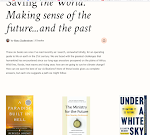But Muslims are not the only terrorists in the world, as witness Uganda's Lord's Resistance Army, a rebel group operating on borders separating Uganda, Sudan, the Central African Republic and the Democratic Republic of Congo. Ostensibly motivated by Christian revelations, it uses child soldiers with impunity.
Inter-ethnic violence also is a curse, and probably to date conflicts like those which have pitted Hutus against Tutsis in Rwanda and Burundi have killed and displaced more than the Muslim groups have.
How did things come to this? Two novels I read recently give a little insight.
The first is Running the Rift by Naomi Benaron. It tells the story of Jean-Patrick Nkuba, a Tutsi in Rwanda who wants to run. He has a chance to represent his country in the Olympics, but is caught up in the 1994 genocide. Much of his family is wiped out, but he escapes. The frenzy that led up to killing spree--estimates are that at least 500,000 people were killed in three months--is portrayed in terrifying detail. The story is not all horror though because it ends with a certain hopefulness that forgiveness is possible.
The subtext is that competition for land can be manipulated to profit the self-interest of individuals, and that vestges of colonial domination have exacerbated things.
There's an O. Henry-like ending that ties things up which I won't spoil, but I think it's fair to say the two stories point out what colonialism has done to the people and ecosystems of Africa. The dignified, wise hunter-gatherers of the first period contrast drastically with the drugged children's army, the Kuti, that Shulman has invented, who thrash about, trying to recreate a pre-colonial state. Similarly, the starving lions who ravage the railroad workers in the first story presage the sorry state of the gorillas that the ethnobotanist hopes to protect.
Both novels are good reads. The Schulman one, however, is plagued by sloppy editing that casts doubt on the background research that she's done. The two that bothered me the most were the reference to iced tea being drunk in 1899 on a ship in the Indian Ocean (where'd the ice come from?) and the repeated reference to jerricans, those useful metal containers that weren't invented until the 1930s.











No comments:
Post a Comment